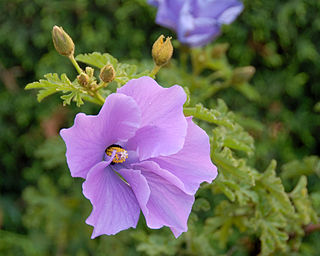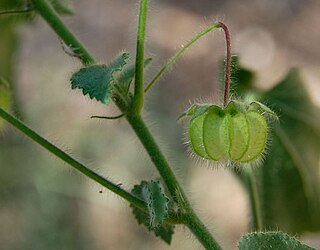
Hibiscus is a genus of flowering plants in the mallow family, Malvaceae. The genus is quite large, comprising several hundred species that are native to warm temperate, subtropical and tropical regions throughout the world. Member species are renowned for their large, showy flowers and those species are commonly known simply as "hibiscus", or less widely known as rose mallow. Other names include hardy hibiscus, rose of sharon, and tropical hibiscus.

Thespesia is a genus of 13 flowering shrubs and trees in the Hibiscus family, Malvaceae, although within the family they are more closely related to cotton plants (Gossypium). The genus is distributed from the South Pacific through Asia, Africa, and the Caribbean.
Bastardiopsis is a genus of trees in the family Malvaceae, containing the following species:
Paul Arnold Fryxell (2 February 1927, Moline, Illinois – July 11, 2011 Claremont, California was an American botanist.

Malvoideae is a botanical name at the rank of subfamily, which includes in the minimum the genus Malva. It was first used by Burnett in 1835, but was not much used until recently, where, within the framework of the APG System, which unites the families Malvaceae, Bombacaceae, Sterculiaceae and Tiliaceae of the Cronquist system, the aggregate family Malvaceae is divided into 9 subfamilies, including Malvoideae. The Malvoideae of Kubitzki and Bayer includes 4 tribes:-

Pavonia is a genus of flowering plants in the mallow family, Malvaceae. The generic name honours Spanish botanist José Antonio Pavón Jiménez (1754–1844). Several species are known as swampmallows.

Alyogyne is a genus of flowering plants in the family Malvaceae which are endemic to Australia. Its species were formerly in the genus Hibiscus but were split off starting in 1863 with H. hakaeifolius. In 1915 Lewton transferred H. cuneiformis and in Fryxell (1968) H. pinonianus and H. huegelii followed. A recent revision has created many new species.

Phymosia is a genus of flowering plants in the family Malvaceae.
Wercklea cocleana is a species of plant in the family Malvaceae. It is endemic to Panama. It is threatened by habitat loss.

Wercklea flavovirens is a species of plant in the family Malvaceae. It is endemic to Jamaica. It is threatened by habitat loss as forest is cleared to make way for banana plantations. The few individuals surviving in the wild are found mostly on Holland Mountain, with one tree in One Day Cave, Bethel. The area of the former population on Hog House Hill, John Crow Mountains is now a banana plantation.
Wercklea grandiflora is a species of plant in the family Malvaceae. It is endemic to Panama. It is threatened by habitat loss.
Wercklea intermedia is a species of plant in the family Malvaceae. It is endemic to Ecuador. Its natural habitat is subtropical or tropical moist lowland forests.

Alyogyne huegelii is a flowering plant found in the Southwest botanical province of Western Australia, extending along its entire coastline.

Iliamna is a small genus of flowering plants in the mallow family, endemic to North America. It is related to the bush mallows of California (Malacothamnus) and to Phymosia of Mexico, Central America and the Caribbean. These perennial herbs are known commonly as wild hollyhocks and sometimes as globe mallows, Kankakee mallow, Kankakee globe mallow, and Streambank wild hollyhock. More often, the latter terms refer to members of the genus Sphaeralcea, which belong, like Iliamna, to the "typical" mallow tribe (Malveae) of the mallow and hibiscus subfamily Malvoideae. The name of the genus, proposed by Edward Lee Greene, appears to be a reference to Iliamna Lake in Alaska, even though the genus Iliamna does not occur in Alaska

Alyogyne hakeifolia is a species of flowering plants found in southern regions of Australia. The plant is similar to a Hibiscus and was assumed to be part of that genus for many years. It is known to have been cultivated in England since the mid nineteenth century.

Herissantia is a small genus of flowering plants in the mallow family sometimes referred to as bladder mallows. These are five species of annual and perennial herbs with trailing stems and bladderlike fruits. They are native to the tropical and warm temperate Americas. The most widely distributed species is Herissantia crispa, which can be found on other continents as an introduced species.

Hibisceae is a tribe of flowering plants in the mallow family Malvaceae, subfamily Malvoideae.
Radyera is a genus of flowering plants in the family Malvaceae.
Macrostelia is a genus in the tribe Hibisceae - in the family Malvaceae. The genus consists of three species: M. calyculata Hochr., M. involucrata Hochr., and M. laurina (Baill.) Hochr. & Humbert. Macrostelias - all native to Madagascar - distinguish themselves from most other genera in Hibisceae by typically bearing flowers with a long corolla tube. Although members of Hibiscus - an example of one of these other genera - may bear flowers with proximally connate petals, such connation occurs only at the very base of the petals.

Cienfuegosia is a genus of plants, in the family Malvaceae and placed in the tribe Gossypieae. Species can be found in central and south America, Africa including the Arabian peninsula.













